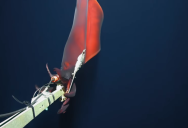Rare Footage Of Giant Squid Shows How Its Bioluminescent Glows When It Attacks

There really is no limit to the coolness – and weirdness – factor of the animals that live under the deep blue sea.
For the ones that typically live really far down, we only get only rare and fleeting glimpses.
This one, of a glowing giant squid, is one of the best ones ever.
The squid, swimming in the Pacific Ocean, floats toward the camera before reaching out with a bioluminescent arm to grab the device. Once it realizes the camera isn’t prey, it quickly leaves.

The footage of the Dana octopus squid (Taningia danae) was captured by scientists at the University of Western Australia and Kelpie Geosciences in the UK.
They were filming at a depth of 3,280 feet near the Nova Canton Trough.
The Dana octopus squid can grow up to 7.5 feet, researcher Heather Stewart says this one was much smaller.
“The squid, which was about 29 inches long, descended on our camera assuming it was prey, and tried to startle it with its huge bioluminescent headlights. It then proceeded to wrap its arms around one of the other cameras which in turn captured the encounter in even greater detail. I think we were very lucky to have witnessed this.”
The animal’s bioluminescence is the result of photophores, a specialized light-producing organ found in an array of organisms that live in the deep.
The ones on the Dana octopus squid are the largest known, and by a lot. They have two giant photophores around the size of a lemon, while most are numerous and tiny.

Scientists have a variety of theories as to why this squid’s are different, with the leading theory being that they use it to dazzle and disorient their prey.
It could also be to illuminate the environment around them in order to help them see what’s around them.
Their obscure habitat and elusive behavior makes them hard to study, so even short bits of knowledge like this one are a gold mine of information.
Marine biologists like Professor Alan Jamieson are grateful for it.
“Many records of this species are from strandings, accidental bycatch or from the stomach contents of whales. The rarity of live observations of these amazing animals makes every encounter valuable in gathering information on geographic locations, depth, and behavior, plus it is such a unique animal that we hardly ever get to see, so we had to share it.”
I mean, it’s pretty cool for the rest of us, too.
I wonder what else is down there?
If you thought that was interesting, you might like to read about why we should be worried about the leak in the bottom of the ocean.

Sign up to get our BEST stories of the week straight to your inbox.




